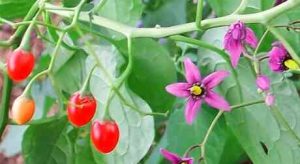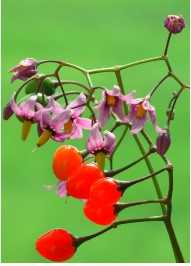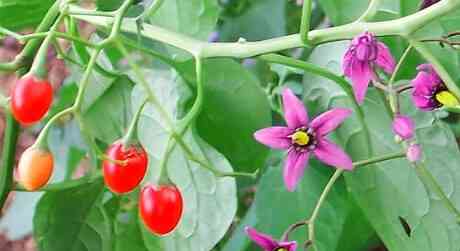Bittersweet nightshade
Latin name: Solanum dulcamara 
Bittersweet nightshade is a small perennial vine originally from Eurasia, making a spectacular display in autumn.
It is a member of the nightshade family, an important family of Solanaceae with many interesting features.
It is a perennial creeping shrub with stems up to 3 m tall. The leaves are dark-green to purple, 2 cm to 10 cm long, and often have one or two small ear-like lobes near the base.
The flowers are star-shaped and have stamens in a prominent yellow cone. It produces round or egg-shaped berries, green when unripe and bright red when ripe. It provides a stunning display of bright blossoms and delicious bright red berry clusters.
The fruit is an oval red berry about 1 cm long, soft and juicy, similar to a small tomato and fragrant and edible to some birds.
It prefers moisture in mesic areas and is often found along lakes, streams, rivers, creeks and marshes as well as field edges, gardens, parks and roadsides.
This plant contains solanine and is toxic to humans, pets and livestock. It has a strong, unpleasant smell, so most animals will avoid it, and poisoning from this plant is not very frequent. The berry’s attractive and familiar appearance makes it dangerous for children.
The berry’s is native to North Africa, Europe and Asia, but has spread throughout the world. The plant is relatively important in the diet of some species of birds, such as the European thrush, which eat its fruit, are immune to poison, and disperse the seeds abroad.
It grows in all types of terrain with a preference for wetlands and the understory of riparian forests. Along with other climbers, it creates a dark and impenetrable shelter for diverse animals.
The plant grows best in dark areas where it can get morning or afternoon light. An area that receives bright light for many hours slows down its development. It grows more easily in moist soil rich in nitrogen. When grown for medicinal purposes, it grows best in a dry, open environment.
Bittrow nightshade has been valued as a herb since ancient Greek times. In the Middle Ages the plant was considered effective against witchcraft and was sometimes hung around the necks of cattle to protect them from the “evil eye”.
Biological activity
This plant is one of the less toxic members of the Solanaceae. Due to the strong bitter taste of the fruit, cases of poisoning in humans are very rare. Incidentally, the fruit is said to have a sweet aftertaste, hence the local name Tita.
The stems are approved for external use as adjunctive therapy in chronic eczema.
Medicinal use
Solanum dulcamara has a variety of documented medicinal uses, all of which are advised to be used with due caution as the entire plant is considered poisonous. Always consult a professional before using a plant herb. Only adults have a record of drug use and may be allergic to bittrow nightshade; Medicinal use is not recommended in this case.
Use of stem
Bittrow nightshade stem is considered considerably less toxic than the rest of the plant and is used to treat most skin conditions. There are records of its use in the treatment of mild recurrent eczema, psoriasis, scabies and dermatomycosis. The stems are harvested when they are still leafless and cut into small pieces. They are mostly known to be applied to the skin in liquid form, but it is also possible, although not recommended, to infuse into drinks. The stem has also been used to treat bronchitis, asthma, and pneumonia.
Uses of leaves, fruits and roots
Bittrow nightshade leaves are known to treat warts and tumors, while the fruit can treat conditions of the respiratory tract and joints. It has been documented that Native Americans in North America used the roots to relieve fever and nausea.
Bittersweet nightshade is poisonous
Bittersweet is a perennial vine with seeds and root nodes on its stem.
Flowers bloom from May to September. Plants can soon grow to 30 feet tall.
All parts of this plant give off an unpleasant smell when crushed.
These characteristics help distinguish bittersweet nightshade from other nightshade species.
This vine can serve as an alternate host for pests such as the Colorado potato beetle, so it can cause indirect damage to the crop. If you have a vegetable garden near you, it is best to remove this creeper.
Leaves and berries are poisonous if ingested. Severe cases can lead to paralysis and even death. Cases of poisoning of cattle, horses and sheep have been documented.
The concentration of toxic compounds in the plant may vary by growth stage, but regardless, the leaves and berries of this plant should be considered toxic.
Bittersweet leaves and berries are poisonous and unsafe. Ingestion of leaves or berries can cause symptoms of poisoning such as vomiting, diarrhea, convulsions, slow breathing and death.
Bitter nightshade is unsafe for children when taken by mouth. Some children may die from eating unclean bittersweet nightshade berries.
Stomach conditions such as ulcers or IBS Avoid using bitter nightshade if you have one of these conditions. It can irritate the stomach and intestines and make these conditions worse.
Bittersweet nightshade is unsafe when taken by mouth during pregnancy or breastfeeding. Some of these plant chemicals have been linked to birth defects in animals.
There isn’t enough reliable information to know if applying bitter nightshade to the skin is safe while pregnant or breastfeeding.
Be safe and avoid use Bittersweet nightshade.
Deadly nightshade vs bittersweet nightshade
Bittersweet, also known as woody nightshade, has flowers similar in color to deadly nightshade.
Bittersweet flowers have noticeable yellow anthers and hang from purple stems. The berries are red rather than black, although both are poisonous.
It is not the same plant as the deadly nightshade or belladonna (an unusual and highly poisonous plant).
Bittersweet nightshade, however, is somewhat poisonous and has caused poisoning damage to livestock and pets, and even death to children who have eaten it.
Berries Fortunately, bitter nightshade has a strong, unpleasant odor, so most animals will avoid it, and poisoning from this plant is not very frequent.
Bittersweet nightshade flowers and berries The whole plant contains solanine, the same toxin found in green potatoes and other members of the nightshade family, and it also contains a glycoside called dulcamarin, which is one of the toxins found in deadly nightshade, similar in structure and effects to atropine.
Toxin levels vary with soil, light, climate and growth stage. Ripe fruits are generally less toxic than leaves and unripe berries, but ripe berries can also be toxic.
References:
https://en.wikipedia.org/wiki/Solanum_dulcamara
